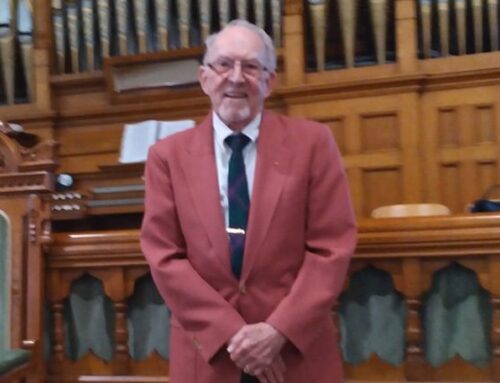While You Walk
I take walks to clear my head, move my body, enjoy nature, and pray. Only occasionally do I walk as a means of transportation. Usually that occurs when I travel away from home. I’ll explore an unknown city by foot. It slows me down and provides unexpected encounters and experiences.
For the disciples in the Lukan account, walking was their primary means of transportation. The road to Emmaus might have been able to accommodate horses and chariots, but these two travelers make their way by foot. Even at a brisk pace, this journey will take a couple of hours to make. They use the time to process all they have seen and heard in the last days and especially that morning. It was, after all, still the day of Jesus’ resurrection. They did not think of it that way yet, they were astounded by the report of the women of the empty tomb, and they did not understand what it meant or believe in its possibilities.
And returning from the tomb they told all this to the eleven and to all the rest. 10 Now it was Mary Magdalene, Joanna, Mary the mother of James, and the other women with them who told this to the apostles. 11 But these words seemed to them an idle tale, and they did not believe them. (Luke 24:9-11)
While processing their uncertainty and confusion, Jesus shows up. The lectionary immerses us in these accounts of Jesus’ first appearances to his disciples. These two were not part of the twelve, but they are not merely members of the crowd either. They heard the firsthand account of the women who went to the tomb, but unlike Peter who grabbed that line of hope and ran to the tomb, these two hit the road for a walk.
In the Lukan version of events, Jesus does not go back to the tomb. Rather, he meets them on the road. Consistent with other first encounters, his disciples do not recognize Jesus. There’s something about his resurrected body that keeps his closest companions from knowing immediately that they are in his presence. This text suggests that their view of him was divinely shielded until the appropriate time. It’s interesting that in these accounts, across Gospel writers, that recognition comes from a moment of deeper connection: the calling of Mary by name, revealing wounds, and now, breaking of bread. At the same time, Luke tells a particular story that is unique in content and intent:
At the center of Luke 24, and dominating Luke’s Easter narrative, is a lengthy account, found only in Luke, of two disciples’ encounter with the risen Jesus on a journey to Emmaus. The passage sews together important narrative threads as it recapitulates the events of the Jerusalem ministry and passion, relates them to the hope of a people’s (and city’s) liberation, and through interpretation of Scripture and solidarity at table brings followers of Jesus from lack of sight and insight to deepened perception. Even in the recent hope-shattering events, they come to see the fulfillment of God’s purposes for the Messiah and his people. Luke thus tells the story of the postcrucifixion community gathered around Jesus as it discovers the resources to deal with the “cognitive dissonance between their experience and their convictions.”
John T. Carroll
I’m not sure we can fully appreciate the spiritual, mental, and emotional overload the disciples experienced in these few days. We take the journey through Holy Week, but coming from the other side of these events, with the benefit of two millennia’s worth of processing and reflection at our disposal, our experience is one of appreciation, humility, grief, awe, and joy among other emotional responses. I’m not sure how many of us are afraid. We might empathize with the doubt and uncertainty they faced; we may envy the assurance we assume they received as eyewitnesses to these events. But as eyewitnesses, they lived through the trauma as much as the miracle, and their fear was an understandable response.
Perhaps, that fear explains why these two make the curious decision to leave town after secluding themselves with the other disciples just at the point of victory. It’s like watching a television series for seven seasons but refusing to watch the final episode. It’s reading an epic novel or biography up to and excluding the last chapter. It’s running a marathon and walking off just before reaching the finish line. It makes no sense. They just heard that Jesus was alive, and this is when they decide to leave Jerusalem for Emmaus. It could not wait a day?
Their response reminds us that not all rejection is done harshly or with animus. A risen Jesus would fulfill their hearts’ desire, but that hope seems impossible to them. They aren’t just taking a walk; they’re running away. They find they cannot escape, however, as even their conversation is drawn to the impossible. Jesus meets them at that crack of receptivity. He eases them into his identity because even good news, at times, becomes hard to receive. This is a consistent theme through the Lukan account of Jesus:
He also brings in angels, characters who prophesy, and the Holy Spirit. According to Luke, God proclaims Jesus’ messianic identity even before his conception when the angel Gabriel describes him as “the Son of the Most High,” the one who will inherit David’s throne and “reign over the house of Jacob forever” (Luke 1:32-33). This is confirmed by three Spirit-filled prophets: John the Baptist (in utero), his mother Elizabeth, and his father Zechariah (Luke 1:41-44, 76). When Jesus is born in Bethlehem, “the city of David,” angels announce the advent of “a Savior, who is the Messiah, the Lord” (Luke 2:11). Prompted by the Holy Spirit, Simeon recognizes Jesus as “the Lord’s Messiah” (Luke 2:25-32). Jesus’ first public act is the preaching of a sermon based on Isa. 61:1-2, a prophecy that outlines the mission of one “anointed” by God (Luke 4:16-21). The third time Jesus predicts his suffering and death, Luke adds to Mark’s account that “everything that is written about the Son of Man by the prophets will be accomplished” (Luke 18:31).
Jocelyn McWhirter
Only those who are prophets themselves seem to catch and hold these improbable announcements. Others reject not only Jesus but the prophecy of others, like the women who proclaimed the resurrection early that morning. Rejection may look like crucifixion or even indifference, but it may also look like taking a walk to Emmaus instead of continuing to wait for what comes next with Jesus.
Fortunately, Jesus is relentlessly and persistently incarnational. He’s with those who seek him (the women at the tomb), those who wait (the secluded disciples), and those who run away (the travelers to Emmaus). He remains with them and makes the connections between the teaching of the prophets (including Jesus himself), his ministry, and the recent events of the passion. He does this first through teaching (Word) and then by sharing a meal (Table)…truly “a prophet mighty in deed and word.”
The main contribution of the Emmaus story to Luke’s guest Christology is in showing how the resurrected Jesus continues to have meal fellowship with his followers. There is a clear continuity between the miraculous meal in the desert, the visit to the two sisters, the last supper with the disciples, and the meal with two followers at Emmaus. In all of these meals Jesus the guest becomes the host, providing for physical as well as spiritual needs. After Easter the risen Jesus visits his followers and stays with them (cf. the repeated μ6ν6ιν, 24:29). He uses two ways of staying with them: through the Word, which causes their hearts to burn, and through their shared meals, where he is the invisible guest. Both are ways in which the resurrected Jesus accompanies his people as guest and host. Jesus as guest is not only the receiver of hospitality, but also the giver of gifts – the Emmaus narrative offers the climactic gift of the visiting Jesus: his continuing presence as risen Lord!
M. C. Dippenaar
There’s a moment in this text where it appears that Jesus will leave before they know who he is, but they aren’t ready for him to go. He remains with them until they recognize him. That’s when he leaves. It seems abrupt and was likely jarring to them. But that propels them back. With the same immediacy they left Jerusalem, they set off to return. Their journey fulfilled the purpose they were afraid to wait for and answered the prayer they dared not hope for as Jesus met them while they walked.
This article was first posted on the United Church of Christ site:






